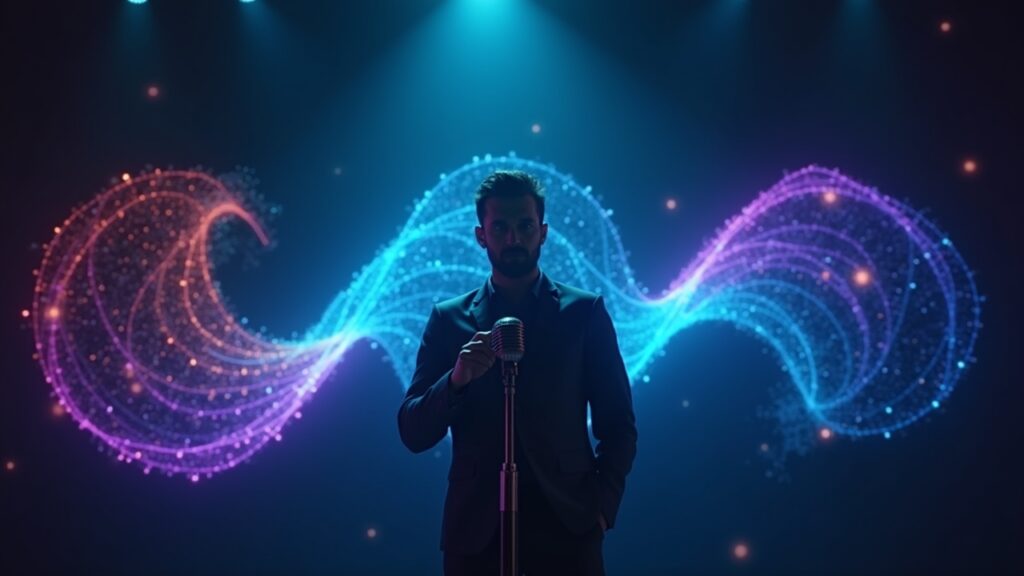Advertisements
Holy smokes, did you know that the AI voice cloning market is expected to hit $4.8 billion by 2028? I nearly fell off my chair when I read that stat last week!
Let me tell you, voice cloning technology has completely blown my mind. Just last month, I accidentally freaked out my sister by calling her with a cloned version of our mom’s voice (yeah, not my brightest moment). But it really drove home how incredibly powerful – and slightly terrifying – this tech has become.
If you’re curious about how voice synthesis, AI voice generation, and all this digital voice replication stuff actually works, you’re in for a treat. I’ve been knee-deep in this technology for the past year, making plenty of mistakes along the way!
What Exactly Is Voice Cloning Technology?

So here’s the deal – voice cloning is basically when AI learns to mimic someone’s voice so well that it sounds exactly like them. It’s kinda like having a digital twin of your vocal cords.
The technology uses something called deep learning algorithms (fancy term for smart computer programs) to analyze tons of audio samples. I remember when I first tried ElevenLabs, I only needed to upload about 30 seconds of my voice. Within minutes, boom – the AI was reading Shakespeare in my voice!
What really gets me is how the synthetic voice captures not just the sound, but also speech patterns, intonation, and even those little quirks we all have. My cloned voice even included my annoying habit of saying “um” between sentences.
How Voice Cloning Actually Works (The Non-Techy Version)
Okay, I’ll try to break this down without getting too nerdy on you. The process starts with neural networks – think of them as the brain of the operation.
First, you feed the AI your voice recordings. The more audio data you provide, the better the results (learned this the hard way when my first attempt sounded like a robot with a cold). The AI then breaks down your voice into tiny pieces, analyzing things like pitch, tone, and rhythm.
Here’s where it gets wild – the text-to-speech synthesis part. The AI can then take any text and speak it in your voice! I’ve used tools like Descript’s Overdub to fix podcast mistakes without re-recording entire segments.
The whole process usually takes anywhere from a few minutes to a couple hours. Pretty insane when you think about it.
Real-World Applications That’ll Blow Your Mind
This is where things get really interesting! Voice cloning isn’t just some cool party trick.
In the entertainment industry, it’s being used for dubbing movies and creating audiobooks. I actually helped a friend who’s an author create an audiobook version of her novel using her own cloned voice – saved her weeks of recording time!
For folks with speech disabilities or conditions like ALS, this technology is literally life-changing. Companies like Acapela Group are creating personalized voices for people who might lose their ability to speak.
Businesses are using voice avatars for customer service too. Though honestly, some of these still creep me out a bit when they sound too human-like.
The Good, The Bad, and The Slightly Scary
Let’s be real – this tech has some serious pros and cons.
On the awesome side:
- Content creators can produce stuff way faster
- People can preserve their voices before medical procedures
- Language learning apps can use native speaker voices more efficiently
- Podcast editing becomes a breeze (trust me on this one!)
But here’s where it gets dicey. Voice authentication systems can potentially be fooled, and deepfake audio is becoming a real problem.
I actually had someone try to scam my elderly neighbor using a cloned voice of her grandson. Luckily, she was smart enough to call him directly to verify. This stuff keeps me up at night sometimes.
Getting Started With Voice Cloning (Responsibly!)

If you wanna try this out yourself, here’s what worked for me.
Start with legitimate platforms like Murf.ai or Play.ht. Most of these offer free trials, which is perfect for testing the waters. Upload clear audio samples – I learned that bathroom recordings sound terrible (too much echo!).
Always, and I mean ALWAYS, get consent before cloning someone else’s voice. This should go without saying, but apparently it needs to be said. Also, check your local laws – some places have strict rules about voice biometrics and synthetic media.
Your Voice, Your Rules
Look, voice cloning technology is here to stay, whether we like it or not. It’s revolutionizing how we create content, communicate, and even preserve memories.
But with great power comes… well, you know the rest. We gotta use this stuff responsibly. Always be transparent when using cloned voices, respect people’s privacy, and for the love of all that’s holy, don’t use it for evil!
Remember to protect your own voice too. Be careful about what audio you put out there, and maybe think twice before doing those viral voice challenges on social media.
If you found this deep dive into voice cloning as fascinating as I did, you’ll love exploring more cutting-edge tech topics over at Tech Digest. We’re always breaking down the latest innovations in ways that actually make sense!




[…] as fascinated by this stuff as I am, keep exploring and learning. And hey, check out more tech deep-dives over at Tech Digest – we’re always geeking out about the latest developments in the […]